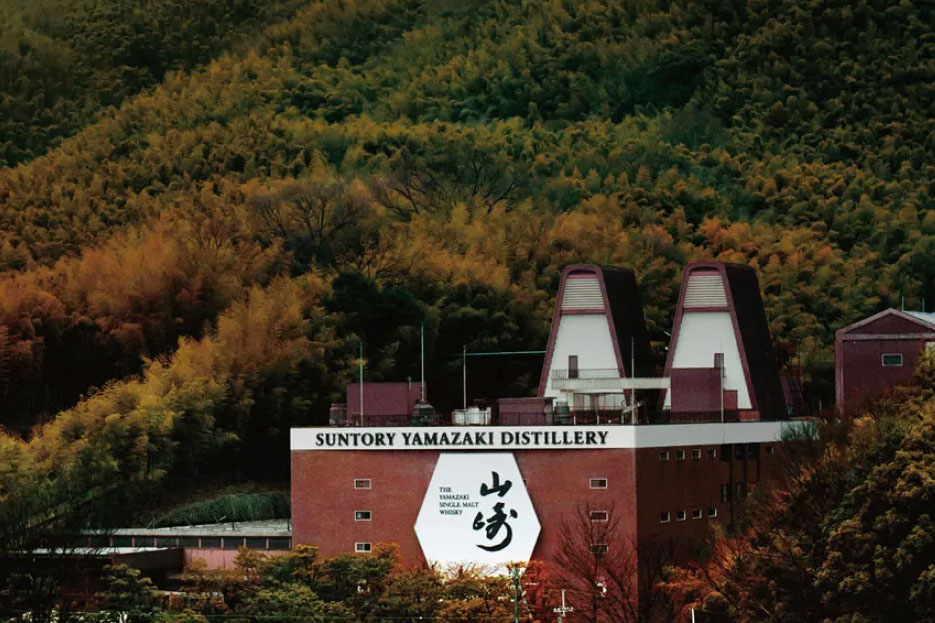Yamazaki’s story
The story of Yamazaki is essentially the story of the whisky industry in Japan. Yamazaki is the country’s oldest whisky distillery. The idea of the Japanese industry’s pioneer, Shinjiro Torii, was to build a distillery and corner the potential market for whisky sales in Japan. This was over a century ago in 1923 and he located the facility in the rural village of Yamazaki, which lies between the cities of Osaka and Kyoto.
The current distillery has a capacity of seven million litres per year, making it the largest whisky distillery in Japan and beating most in Scotland for production per annum. It also has the busiest visitor centre of all Japanese distilleries and this includes a bar that contains over 120 different Yamazaki whiskies of differing ages and cask types.
The raw materials for their whisky production are sourced from around the world. Barley is grown on a small scale in the local area but most is imported from the UK, Europe, North America or Australia. Peat used to be imported from Scotland but Yamazaki stopped malting their own barley in 1971, so now lightly and heavily peated barley is imported when needed. Casks are largely imported from the American bourbon and Spanish sherry industries, although Yamazaki regularly part mature their whisky in Japanese oak casks called mizunara.
Their experimentation with mizunara casks began after World War II, when there was a shortage of sherry casks and strained relationships restricted anything coming from the US. Suntory were pioneers in this field and discovered that mizunara oak contained more natural oils and these were then imparted in to the whisky giving unique flavours and characteristics. However, mizunara is also very porous compared to other forms of oak and as a result more whisky is lost through evaporation or leakage. Therefore, whisky is mostly part matured in mizunara to minimise any losses, but is seen as an integral part of the maturation process for Yamazaki malts and Hibiki blends, which are also produced by Suntory.
Yamazaki’s history
When Shinjiro Torii announced that he was opening a whisky distillery in the early 1920s, most people in Japan thought that he was mad. He already imported European wines, primarily those from Spain, into Japan and owned a company that produced plum-based dessert wines and liqueurs. Torri sent one of his workers, an apprentice named Masetaka Taketsuru, to Scotland to learn about the production of whisky, the traditional methods and to immerse himself in the whisky trade.
Taketsuru spent nearly three years working at various distilleries in different whisky producing regions so as to learn differing styles of single malt distillation. This included Mortlach in Speyside and Lagavulin on Islay. He married a Scottish woman, Jessie Roberta Cowan, during that time. She was known as Rita to friends and family. He then reported back to Torii and plans were started to build the first Japanese whisky distillery.
Prior to his Scotland trip, Taketsuru and Torii went around Japan to research the location – Taketsuru selected a site on the northern island of Hokkaido and Torri choose the site at Yamazaki. The final decision was the Yamazaki site, as Torri considered three main factors – the exceptionally high quality of the local spring water, the unique climate and humidity created by the convergence of three rivers in the area and the fact that it lay close to the best transport link in Japan at the time, between Osaka and Kyoto.
The decision would cost Torii the services of Taketsuru in time. A decade later, and after opening and working at Yamazaki for almost a decade, Taketsuru went to start his own distillery. This would became Yoichi and was located at Taketsuru’s original choice of site on Hokkaido, as he felt this had the most Scottish-like conditions. He and Rita would go on to establish Nikka, Japan’s second largest whisky producer.
The Kotobukiya Company, that was owned by Shinjiro Torri, funded the building of Yamazaki and production started in 1924, with Masetaka Taketsuru as distillery manager. Kotobukiya changed its name to Suntory in 1929, with the new name being derived from Torii-san, the Japanese title of Shinjiro Torii. The first whisky, a blend of their single malt and grain whiskies, was released in 1932. Interestingly, this blend also included some imported single malt from Scotland. Shortly afterwards, Taketsuru left to start his journey with Yoichi, which started production in 1934. The first pure single malt (Yamazaki 12 years old) was not released until 1984 and was followed by the 18 years old in 1994.
Now, Yamazaki single malts are highly sought after and considered some of the best Japanese whiskies available. The range is tight with age statement releases particularly rare and expensive. To help with this, Yamazaki was closed for part of 2023 to carry out a major renovation. Unusually, they have different shapes of stills and these make different styles of spirit. The combination of this, making some non-peated and peated spirit, and maturing in different cask types mean that the blending team have access to a wide variety of spirit for Yamazaki or Hibiki bottlings.
- How to pronounce Yamazaki? yama-zakee
- Country: Japan
- Region: Osaka
- Founded: 1923
- Current owners: Suntory Global Spirits
- Production capacity per year: 7 million litres
- Mash tun: 2 – 1x 4 ton, 1x 18 ton
- Washbacks: 17
- Stills: 16
- Visitor centre: Yes
Yamazaki Distillery
Yamazaki 5-2-1
Mishimagun
Shimamotocho
Osaka
618-0001
tel – +81(0)75 962 1423
house.suntory.com/yamazaki-whisky
Did you know?
Part of the Yamazaki was built on the site of a former temple. When constructing the distillery they decided to build a strine to symbolise this and there are always two casks of maturing whisky placed there as an offerings to the gods.


